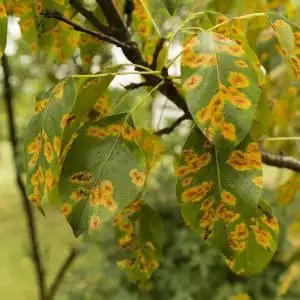It’s hard to imagine that anything as long-lived and large as a tree can come to any harm. But these sturdy stalwarts, like all living things, succumb to illnesses and fall prey to pests. They are giant focal points in our yards, so when one is sick it affects the entire landscape. Learn how to identify both common and serious tree diseases in Ohio and how you can protect your property.
Serious Tree Diseases in Ohio
Dutch Elm Disease. This fatal fungal disease attacks the tree’s vascular system, preventing the proper flow of water and nutrients. The fungus is either transported by the elm bark beetle or spread through the connected root systems (root grafts) of nearby trees. Once one tree is infected, others in the neighborhood quickly follow.
Oak Wilt. This rapid-spreading and deadly disease also affects the vascular system of the tree. Although all oaks are susceptible, the red oak is more so than the white oak species. White oaks are often able to recover, unlike red oaks, which usually succumb to the disease soon after infection. Often occurring in later spring or summer, the symptoms range from leaf discoloration and distortion to dead crowns and leaf drop. Fungal spores are either transported to healthy trees by insects or travel to neighboring trees through interconnected roots.
Most Common Tree Diseases in Ohio
Many illnesses that affect trees are often more of an aesthetic issue and usually don’t cause major damage. However, if left untreated, these diseases can spread or harm the tree indefinitely. Here are some of the diseases found in the Ohio area.
Powdery Mildew. Wondering what that white or gray coating is on your foliage? Most often discovered on shrubs, this fungal disease also infects trees. There are hundreds of varieties of fungi that cause powdery mildew. It’s made up of multiple spores that spread quickly to cover older leaves first, and then move onto newer growths, causing leaves to curl and contort. Symptoms are most noticeable late in the growing season.
Anthracnose. A broad term for a collection of fungal diseases, this infection causes tree leaves to drop off too soon. Other symptoms range from blotches and spots on leaves, partially bare canopies, twig cankers, and dieback. Although it won’t kill the tree, the disease weakens it and makes it more susceptible to pests and other diseases. Anthracnose thrives in cool wet weather during late spring.
Needle blight. Brought about by a fungus, this disease affects mostly pine trees causing needles to brown and premature needle drop. Needle blight destroys lower branches first and rarely tackles the top of a tree.
The One to Watch
Thousand Cankers Disease. Producing widespread fatalities in many species of the walnut tree family, this newly recognized disease was first found in Colorado in the early 2000s, but now is making its way into eastern states. Walnut twig beetles (Pityophthorus juglandis) carrying the fungus tunnel into the tree’s wood. The fungus creates dead areas under the bark, called cankers, which in large numbers damage the tree’s ability to circulate water and nutrients. Symptoms of the disease then become more visible in the form of yellow, wilted, or dead leaves, thinning foliage, and branch dieback. Once the symptoms are visible, an infected tree usually dies within a few years.
Management of Tree Diseases
When it comes to protecting these beautiful assets to your property, prevention is your best bet. A few tips to ensure the health of the trees in your yard:
- When planting, choose disease-resistant trees and purchase them from a well-known garden center or nursery with a good reputation.
- Ask your local tree or lawn professional about preventative fungicide sprays.
- Prune trees regularly and remove dead or diseased limbs to prevent spreading.
- Properly destroy leaves and branches from diseased trees and do not use for compost.
If you suspect that a tree is infected with a serious disease, call in a professional right away. Contact Free Spray Lawn Care at 419-529-5296 and we’ll help you keep your trees healthy and beautiful for years to come.



Comments (0)
Thanks for your comment!
Thanks for your feedback! Your comments have been successfully submitted! Please note, all comments require admin approval prior to display.
Error submitting comment!
There is a problem with your comment, please see below and try again.